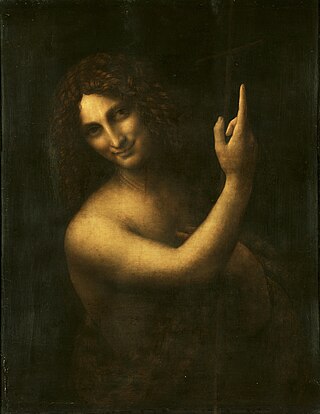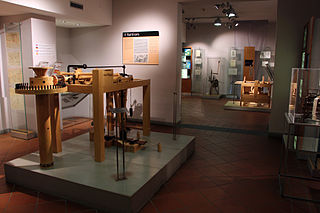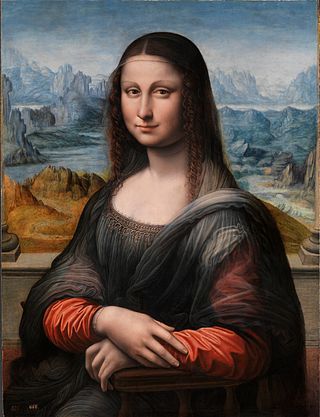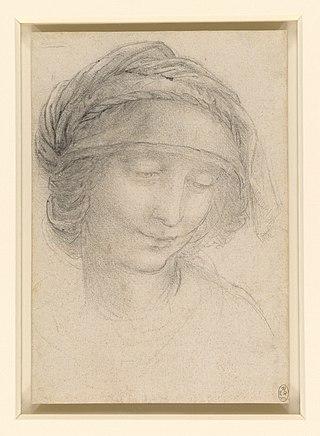Biography
Vincent Delieuvin is an art historian and chief curator of Italian painting of the sixteenth century paintings department of the Louvre since 2006. [1] He has written several books on Leonardo da Vinci. [2] He is a knight of Arts and Letters. [3] A graduate of the Institut national du patrimoine (Museums - State - Jacques Tati Promotion - 2003), [4] he has curated several exhibitions. He has been a member of the editorial board of the Revue de l'Art since 2015. [5]
Winner of the Carnot Foundation grant in 2004, he spent five months in Rome to study the artistic fortune of Federico Barocci. [6] A recipient of the Focillon grant in 2015, he spent several months in the United States thanks to Yale University for his project: "Original, copy, derivation. The work of Leonardo da Vinci through the covers of his followers. Study of Leonardo's works in public collections in the United States". [7]
Delieuvin has commented on the authenticity of one of the paintings under his supervision, the Mona Lisa . In 2005, a scholar at Heidelberg University discovered a marginal note in a 1477 printing of a volume by ancient Roman philosopher Cicero. The note was dated October 1503, and was written by Leonardo's contemporary Agostino Vespucci. This note likens Leonardo to renowned Greek painter Apelles, who is mentioned in the text, and states that Leonardo was at that time working on a painting of Lisa del Giocondo. [8] In response, Delieuvin stated "Leonardo da Vinci was painting, in 1503, the portrait of a Florentine lady by the name of Lisa del Giocondo. About this we are now certain. Unfortunately, we cannot be absolutely certain that this portrait of Lisa del Giocondo is the painting of the Louvre". [9] Circa 1505, [10] Raphael executed a pen-and-ink sketch of the Mona Lisa, with columns flanking the subject. It was thought that the Mona Lisa had been trimmed, [11] [12] [13] [14] but by 1993, Frank Zöllner observed that the painting surface had never been trimmed, [15] which was confirmed through a series of tests in 2004. [16] In view of this, Delieuvin stated in 2017 that the sketch and other copies must have been inspired by another version. [17]
He wrote a book about the Salvator Mundi at the end of 2019 which was reportedly only distributed for 2 hours before being withdrawn from sale due to the exhibition context and political tension with Saudi Arabia's Crown Prince Mohamed bin Salmane, who is said to own it.

The Louvre, or the Louvre Museum, is a national art museum in Paris, France. It is located on the Right Bank of the Seine in the city's 1st arrondissement and home to some of the most canonical works of Western art, including the Mona Lisa and the Venus de Milo. The museum is housed in the Louvre Palace, originally built in the late 12th to 13th century under Philip II. Remnants of the Medieval Louvre fortress are visible in the basement of the museum. Due to urban expansion, the fortress eventually lost its defensive function, and in 1546 Francis I converted it into the primary residence of the French kings.

The Mona Lisa is a half-length portrait painting by Italian artist Leonardo da Vinci. Considered an archetypal masterpiece of the Italian Renaissance, it has been described as "the best known, the most visited, the most written about, the most sung about, [and] the most parodied work of art in the world". The painting's novel qualities include the subject's enigmatic expression, monumentality of the composition, the subtle modelling of forms, and the atmospheric illusionism.

Vincenzo Peruggia was an Italian museum worker, artist and thief, most famous for stealing the Mona Lisa from the Louvre Museum in Paris on 21 August 1911.

La Belle Ferronnière is a portrait of a lady, usually attributed to Leonardo da Vinci, in the Louvre. It is also known as Portrait of an Unknown Woman. The painting's title, applied as early as the seventeenth century, identifying the sitter as the wife or daughter of an ironmonger, was said to be discreetly alluding to a reputed mistress of Francis I of France, married to a certain Le Ferron. Later she was identified as Lucretia Crivelli, a married lady-in-waiting to Duchess Beatrice of Milan, who became another of the Duke's mistresses.

Lisa del Giocondo was an Italian noblewoman and member of the Gherardini family of Florence and Tuscany. Her name was given to the Mona Lisa, her portrait commissioned by her husband and painted by Leonardo da Vinci in the Italian Renaissance.

Saint John the Baptist is a High Renaissance oil painting on walnut wood by Leonardo da Vinci. Likely to have been completed between 1513 and 1516, it is believed to be his final painting. Its original size was 69 by 57 centimetres.

The Isleworth Mona Lisa is an early 16th-century oil on canvas painting depicting the same subject as Leonardo da Vinci's Mona Lisa, though with the subject depicted as being a younger age. The painting is thought to have been brought from Italy to England in the 1780s, and came into public view in 1913 when the English connoisseur Hugh Blaker acquired it from a manor house in Somerset, where it was thought to have been hanging for over a century. The painting would eventually adopt its unofficial name of Isleworth Mona Lisa from Blaker's studio being in Isleworth, West London. Since the 1910s, experts in various fields, as well as the collectors who have acquired ownership of the painting, have asserted that the major elements of the painting are the work of Leonardo himself, as an earlier version of the Mona Lisa.

The 16th-century portrait Mona Lisa, or La Gioconda, painted in oil on a poplar panel by Leonardo da Vinci, has been the subject of a considerable deal of speculation.

Louis Béroud was a French painter of the late 19th, early 20th century. Some of his paintings are visible at the Musée Carnavalet and The Louvre in Paris. On 22 August 1911 Béroud came to The Louvre to sketch his painting Mona Lisa au Louvre but where the famous La Joconde, by Leonardo da Vinci, should have stood, he found four iron pegs. Béroud contacted the section head of the guards, who thought the painting was being photographed for marketing purposes. A few hours later, Béroud checked back with the section head of the museum, and it was confirmed that the Mona Lisa was not with the photographers. The Louvre was closed for an entire week to aid in investigation of the theft.

Gian Giacomo Caprotti da Oreno, better known as Salaì was an Italian artist and pupil of Leonardo da Vinci from 1490 to 1518. Salaì entered Leonardo's household at the age of ten. He created paintings under the name of Andrea Salaì. He was described as one of Leonardo's students and lifelong companion and servant and was the model for Leonardo's St. John the Baptist,Bacchus and Angelo incarnato.

Salvator Mundi is a painting attributed in whole or in part to the Italian High Renaissance artist Leonardo da Vinci, dated to c. 1499–1510. Long thought to be a copy of a lost original veiled with overpainting, it was rediscovered, restored, and included in an exhibition of Leonardo's work at the National Gallery, London, in 2011–2012. Christie's, who sold the work in 2017, stated that most leading scholars consider it an original work by Leonardo, but this attribution has been disputed by other leading specialists, some of whom propose that he only contributed certain elements; and others who believe that the extensive restoration prevents a definitive attribution.

The Museo Ideale Leonardo da Vinci is located in Vinci, Leonardo da Vinci's birthplace, in the province of Florence, Italy. It is part of the Museo leonardiano di Vinci.
Here below is a chronology of fictional and semi-fictional stories that revolve, either wholly or partially, around the famous Mona Lisa, a portrait of Lisa del Giocondo painted by Leonardo da Vinci during the Renaissance in Florence. The years listed on the left refer to the year of release of these works of fiction.

The Prado Mona Lisa is a painting by the workshop of Leonardo da Vinci and depicts the same subject and composition as Leonardo's better known Mona Lisa at the Louvre, Paris. The Prado Mona Lisa has been in the collection of the Museo del Prado in Madrid, Spain since 1819, but was considered for decades a relatively unimportant copy. Following its restoration in 2012, however, the Prado's Mona Lisa has come to be understood as the earliest known studio copy of Leonardo's masterpiece.

The two–Mona Lisa theory is a longstanding theory proposed by various historians, art experts, and others that Leonardo da Vinci painted two versions of the Mona Lisa. Several of these experts have further concluded that examination of historical documents indicates that one version was painted several years before the second.

Studies of an Infant is a set of eight red chalk drawings on red ochre-prepared paper by Leonardo da Vinci, housed in the Gallerie dell'Accademia in Venice. These are representations of all or part of the body of a very young child, considered to be preparatory studies for the Infant Jesus in the oil painting The Virgin and Child with Saint Anne in the Louvre.

The Head of the Virgin in Three-Quarter View Facing Right is a drawing on paper in pierre noir pencil and red chalk, attributed to the Florentine painter Leonardo da Vinci and kept at the Metropolitan Museum of Art in New York.

The Virgin and Child with Saint Anne is a cartoon said to have been created by Leonardo da Vinci as part of his "Virgin and Child with Saint Anne" project, and now considered lost. It is known from a letter written on April 3, 1501, by Fra Pietro Novellara, Isabella d'Este's envoy to the painter. For this reason, it is sometimes referred to as "Fra Pietro's cartoon". Although still hypothetical, its existence seems to be confirmed by paintings by Raffaello and Andrea del Brescianino that are said to have been made from it, as well as by various pencil studies.

The Study for the Virgin's Right Arm is a drawing by the Florentine painter Leonardo da Vinci that is kept at Windsor Castle in the United Kingdom. It is drawn in charcoal or black stone, gray chalk, ink, and white gouache highlights on red-tinted paper.

The Study for the head of St. Anne is a drawing on paper executed in black stone by Leonardo da Vinci and preserved at Windsor Castle. It is a portrait of a woman, and is considered to be the preparatory study for the head of Saint Anne in the painting Sainte Anne, la Vierge et l'Enfant Jésus jouant avec un agneau in the Louvre Museum.

















